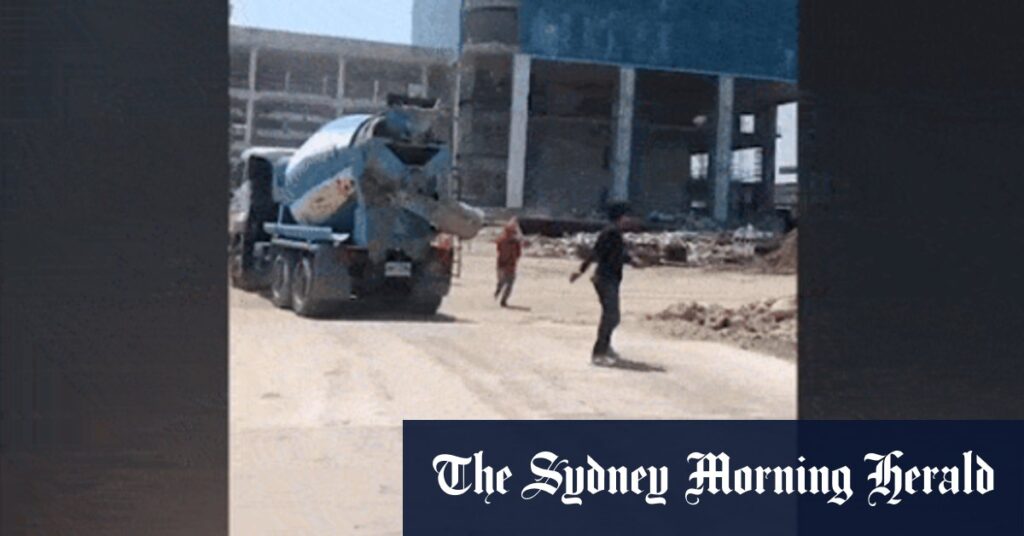But now, with at least a dozen cranes hovering over the skyline, gray skeletons of steel and concrete that once signalled economic growth have taken on an ominous quality.
Loading
Somreutal Nilbanjong, 34, found herself gazing at one such building downtown on Sunday afternoon as she walked home. Asked what she was thinking, she said “it scares me just to look at it”.
A small construction elevator climbed up the exterior through pink scaffolding. She scrolled through her phone until she found a photo of the mountain of rubble a few miles away – the collapsed building, Bangkok’s ground zero.
Goosebumps appeared on her arms and she shuddered.
“I’m afraid it’s going to happen again,” she said.
Government officials have tried to calm people’s nerves and keep people updated.

Thai rescue teams work to extract people trapped in the collapsed building.Credit: Getty
Immediately after Friday’s quake, Prime Minister Paetongtarn Shinawatra issued an urgent alert warning people to be wary of aftershocks for the next 24 hours.
By that evening, she sought to reassure the public by announcing that the situation had stabilised and that residents could return to their homes.
On Saturday, she rode on Bangkok’s elevated railway, known as the Skytrain, to show that the trains were safe. The system had been shut down after the quake and inspected before most of the lines were reopened.
But even as the city has reemerged toward normalcy – malls and markets full, trains rumbling over streets packed with motorbikes – many people are struggling to process something they had thought happened only in places such as Japan or Taiwan.
Kanittha said the experience was so confounding that her mind raced to memories of what she had seen in Japanese comics or manga depicting disasters.
Many people said they weren’t necessarily scared, but that they were forced to ask unexpected questions: Behind glass facades, are buildings really secure? What if there are cracks that cannot be seen? What if there’s a giant aftershock?
Jiraporn Jaichob, 41, a drink stall owner who was having lunch when the temblor struck, said she was making plans for future disasters.
She was thinking of buying a transistor radio since she’d seen cellphone coverage go down. She also created a go bag for family with key documents and supplies.
“With this earthquake, we learned that we don’t know what might happen in a given day,” she said.
“We can die anytime, anywhere, I know – it’s our fate,” she added. “But at least we take care of our lives where we can.”
Thailand upgraded its earthquake-resistant building code in 2007, and experts said the vast majority of the city’s buildings were clearly strong enough to withstand what should still be considered a rare seismic event. Still, some engineers called for greater scrutiny and a potential upgrade in standards and enforcement.
“Look at Japan – they keep developing their laws and design,” said Suchatvee Suwansawat, a professor of civil engineering at King Mongkut University and a former president of the Council of Engineers Thailand. “We should do that as well.”
The collapse of the 30-story building, which had been going up beside a mall and popular weekend market, could be a turning point. It never should have buckled, Suchatvee said, suggesting that something went wrong in design, execution or oversight.
Four years into construction, it was being built by a Chinese state-owned company, the China Railway 10th Engineering Group. The Thai government has promised to investigate and report early findings in a week.
But like other frightening building collapses – the condo tower in Surfside, Florida, which killed 98 people in 2021, or the downing of the World Trade Centre from terrorist attacks on September 11, 2001 – the toll of destruction seems likely to linger.
By dusk on Sunday, shock, grief and dust mingled in the air at the collapse site, where a sizable crowd was gathered. Volunteer rescuers from the police and the military wearing jumpsuits cycled in and out of the area. A crane held two observers over the top of the rubble mountain as men in yellow hats stared up from below.
At the perimeter, the father of a Pakistani worker said people were praying at temples all over Thailand and that he hoped at least half the workers would come out alive.

Shock, grief and dust mingled in the air at the site of the high-rise building collapse.Credit: AP
Aubonrat Setnawet was also still hoping for good news about her husband. He had been on the 23rd floor of the building when the earthquake hit; she had been there too, working, but on the ground floor, not far from where she sat on Sunday in a soft plastic chair near a hard metal fence.
“No updates,” she said quietly. All she could point to were more relatives beside her, as the noisy grind of diggers and dump trucks filled the air.
At the market across the street, Jatupol Sawangphanich, 42, put tape over the slits of a metal grate protecting his tropical fish business.
“Every time they lift the rubble, the dust flies in this direction,” he said.
Beside him, the lights of a usually busy mall had gone dark. Its structural integrity still needed to be tested.
“This happened all over Bangkok,” he said. “I’d rather not go into tall buildings at all.”
This article originally appeared in The New York Times.

